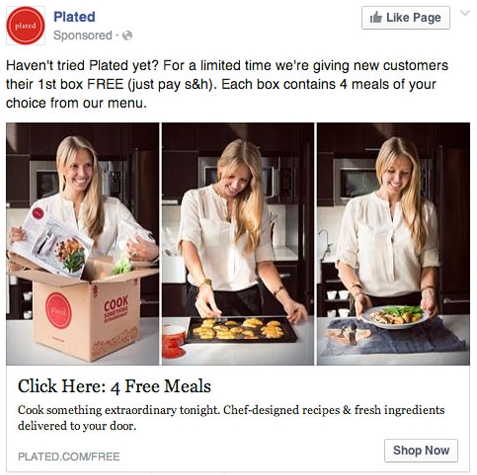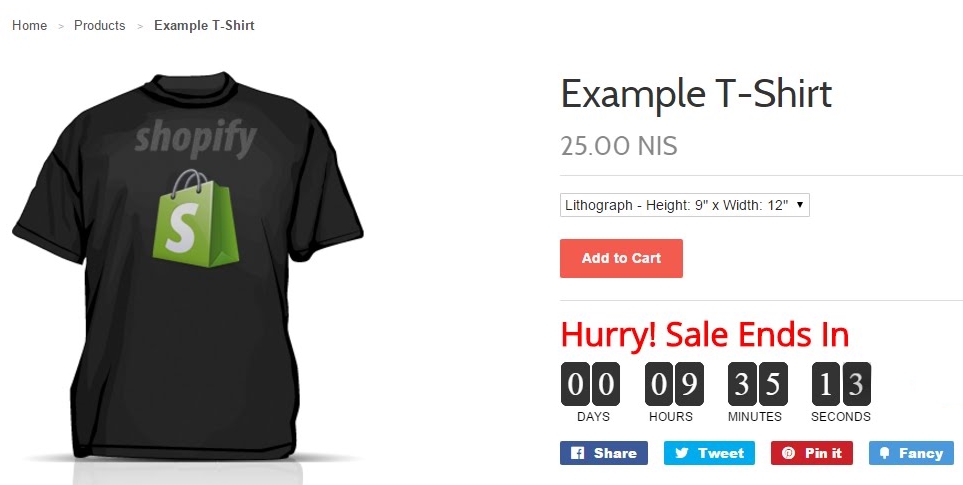When orchestrated properly, Facebook ads will stop readers in their tracks, entice them to click through to your landing page and ultimately, drive conversions. Chronext, a digital marketplace for luxury watches, experienced a 40% boost in traffic and 14x return on investment thanks to a carefully executed ad campaign.
However, if you’re not careful, Facebook ads can quickly become a money pit as General Motors found out. Spending money on Facebook ads will guarantee you a certain level of reach, but if your ads don’t actually connect with your customers or result in financial remuneration, then what’s the point?
In the Age of Information, where people are less responsive to advertising than ever before, creating generic ads for untargeted audiences is not effective. In order to cut through the noise and connect with people, you need to create ads that are highly personalized.
Fortunately, Facebook is the perfect platform to do this. If your ads aren’t connecting with your ideal consumers, it’s likely that you’re making one (or more) of the following mistakes.
1. Mundane or Inappropriate Images
Facebook ads with images receive 2.3x the engagement than those without, so always leverage the power of visual communication in your campaign. Vibrant colors are great, but try to avoid blue and white as a scheme, as this can be confused with Facebook’s branding.
Boring stock photographs won’t captivate anyone’s attention. Likewise, an image that appears like an overt, disruptive product ad is likely to repel people.
Effective ad images look organic within a person’s Facebook News Feed, yet are designed to stand out and strike a resonance with the intended target. Oftentimes, the image that generates the most conversions is not the one you would have anticipated – hence why split testing images is crucial.
In a study performed by Search Engine Land, it was determined that the highest converting image types for Facebook ad campaigns were: happy women, colorful logos and headshots.

You may find that an organic photo of your customers using your product converts better than a typical e-commerce shot with a white background, so don’t be afraid to experiment. By split testing a series of images at a lower cost, you can scale the one which converts the best – minimizing your investment risk.
2. Unspecific or Incorrect Targeting
Even if your ad contains a compelling image, a captivating headline, and an excellent value proposition, none of this will matter if you show it to the wrong audience.
It’s easy to assume that better results can be attained by broadening your audience, but in reality, specificity is the key to ad targeting.

I recommend you create a buyer profile for each campaign. You should note down demographic attributes, such as age, income, and marital status, and also psychographic attributes, such as values, interests and pain points.
Crafting an ad is infinitely easier if you have a specific individual in mind. A buyer profile allows you to craft personalized ads in the form of a one-on-one conversation – this dramatically helps to improve conversions.
3. A Lack of Trust
In a study performed by Zendesk, 90% of consumers stated that seeing positive reviews influenced their buying decisions. If consumers perceive a disconnect between what you’re claiming and what they think you will deliver, conversions will plummet.
Trust-related issues normally occur once the consumer has clicked through to your landing page.
Some of the biggest trust killers include a lack of authentic customer testimonials, unprofessional product photography, an antiquated site design, no terms and conditions, no refund policies, insufficient contact information, no payment symbols and hyperbole-laden sales copy.
4. A Lack of Urgency
A business selling packages for musicians improved its sales by 332% as a direct result of integrating urgency into its marketing strategy. Particularly for lower cost products which are likely to be impulse purchases, there always needs to be a reason for the consumer to purchase then and there, rather than procrastinate.
In a study about digital consumerism by The E-Tailing Group, 47% of online consumers stated they rarely or never pay full price for products. This highlights the importance of limited offers as a marketing tactic.

If you’re using Shopify as your e-commerce platform, a number of easily integrable timers can be downloaded from the app store. A countdown timer on a product page has an immediate emotive effect – if they don’t buy the product now, they might regret it later.
If you show that your product is in short supply because lots of people want it, this leverages social proof to communicate your product is of high value. People are more inclined to buy products that others have already cosigned.
5. Confusing Shipping Options
In the aforementioned study by The E-Tailing Group, 73% of consumers stated that receiving free shipping with their order was very important to them. Increasing the price of your product and providing free shipping to balance out the costs could be worth split testing.
In fact, you may wish to use free shipping as part of the value proposition in your Facebook ad. If the consumer immediately knows that extra shipping costs won’t appear once they’ve hit the purchase button, this removes some of the anxiety of making the purchase.
6. Too Much Jargon
As a product developer or marketer, you can easily get used to using industry terminology to describe your product. Unless your audience is as heavily involved in the technical aspects of your niche as you, avoid using unfamiliar terms.
If a prospect is reading your ad and doesn’t understand some of the terminology, this will immediately destroy the chances of them converting. In other words, speak in plain, conversational prose and don’t make your ads less intelligible than they need to be.
7. You Discuss Features, Not Benefits
People tend to make purchasing decisions based on emotional inclinations rather than rational thinking. By focussing on the emotional benefits of your product in your ad copy (rather than the logical features), people will be more encouraged to buy.
As much as you love the intricacies of your product, your customers are more likely to make a purchase based on the emotional reward they will receive, rather than its utility.
People buy a luxury watch for a sense of identity enrichment. If effective timekeeping was the primary sales driver, digital watches would outsell analog watches ten to one.
8. You Don’t Examine the Competition
Like any art, crafting excellent Facebook ads is infinitely easier if you can learn from those more successful than you. By examining the ads made by other companies, even those in completely different niches, you can start to pick up on common patterns.
I suggest you create a Swipe File in Evernote, containing screenshots of all the ads you come across while browsing Facebook. You might notice that certain phrases crop up time and time again, such as:
- Limited time offer
- Hurry, offer ends
- Just released
A good Facebook doesn’t need to be extravagant or sophisticated, it simply needs to convert. So, don’t be afraid to take inspiration from those who have gone before you.
9. The Tone of Your Ad Is a Mismatch For Your Audience
Just as mixed martial arts equipment and pet supplies would have contrasting buyer profiles, the language and overall tone of the ad need to reflect this. If you’re selling to a demographic that you’re unfamiliar with, I recommend spending some time frequenting niche forums and reading customer reviews for competitors.
Getting to know the levels of formality, speech styles and vocabulary of your target audience is essential so you can replicate their communication styles in your ad and sales copy.
10. Your Headlines Are Uninspiring
Whether you go with a news headline, how-to headline, question headline or direct headline, your headline should ideally address your user’s problem and how your product will solve it. Be crystal clear with your offering and don’t use trickery to entice someone who wouldn’t be a good match for your product.
If you have an amazing USP, include it in your headline. If you can back it up with precise statistics, that’s even better.
Always use powerful, emotive words in your headlines. Also, don’t be afraid to use negativity as an emotional driving force. Some people are motivated by running away from things they dislike, while others are motivated by moving toward things that they like – both play a huge role in purchasing decisions.
In a study comparing negative and positive superlatives in headlines, it was found that negative headlines received a 69% higher click-through rate.
11. You Aren’t Split Testing Enough
The truth is, most Facebook ads don’t actually work. In order to find an ad which results in an excellent cost per conversion, you’ll have to do some experimenting.
While split testing the image often creates the most significant changes in results, other aspects of the ad should also be split tested, including:
- The landing page
- Ad placement
- Body Text
- Headline
- Call-to-action
- Audience
If you’re on a budget, I recommend starting off with one killer image and test it with 3 ads for 5 audiences. You can outsource more design work once your campaign starts getting traction.
For the 3 ads, experiment with the headline, value proposition and body text. Next, create 5 audiences with varying ages, countries, incomes, genders and interests.
Run all 3 ads at a low cost for each audience and track the data. You can tweak and scale the ads which look the most promising and abandon the rest.
Age is one of the most interesting attributes to split test. Although millennials are described as the most typical impulse buyers, it can often be the older generation who convert more successfully.
Hopefully, you’ve found these tips helpful. Don’t get discouraged if your ad campaign isn’t working at first – so long as you’ve got a great value proposition that will benefit a specific audience, you just need to keep tweaking until you gain traction.
Have you struggled to make your ads convert successfully in the past? If so, what tweaks did you make in order to solve the problem? I’d love to hear your responses below:
Image Credits
Featured Image: Pixabay
Screenshots taken by Matt Orlic, February 2017





![[SEO, PPC & Attribution] Unlocking The Power Of Offline Marketing In A Digital World](https://www.searchenginejournal.com/wp-content/uploads/2025/03/sidebar1x-534.png)